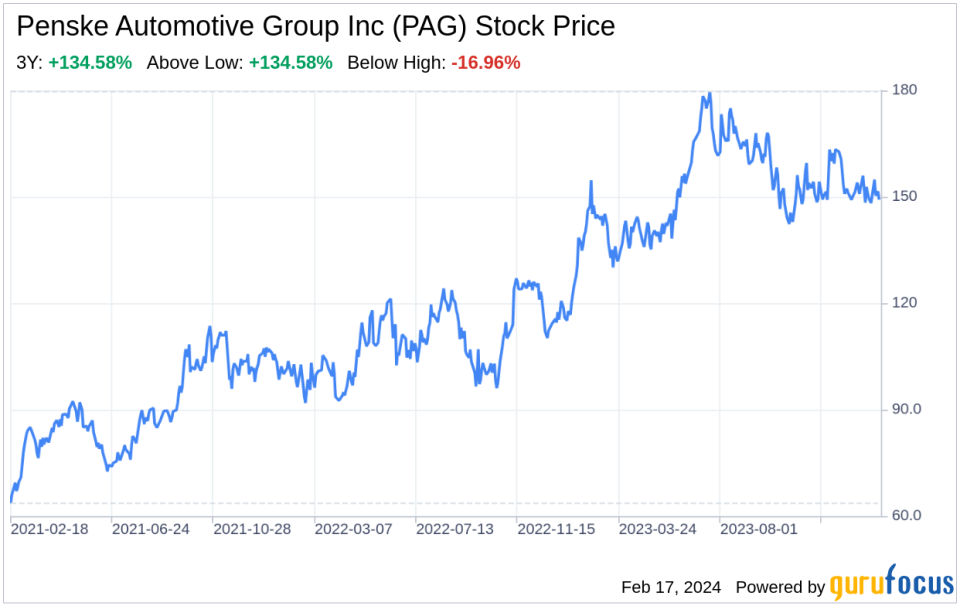Decoding Penske Automotive Group Inc (PAG): A Strategic SWOT Insight
Comprehensive SWOT analysis based on the latest 10-K filing.
Insight into PAG's financial performance, highlighting a diversified portfolio and digital strategy.
Exploration of PAG's market positioning and future growth opportunities.
Assessment of potential risks and competitive challenges facing PAG.
On February 16, 2024, Penske Automotive Group Inc (NYSE:PAG) filed its annual 10-K report, providing a detailed overview of its financial health and strategic direction. As a leading international transportation services company, PAG reported a robust total revenue of $29.5 billion for the year 2023, with retail automotive dealerships contributing $25.2 billion, retail commercial truck dealerships $3.7 billion, and commercial vehicle distribution and other operations $634.0 million. The company's gross profit stood at $4.9 billion, indicating a strong performance across its diversified portfolio. This financial overview sets the stage for a deeper SWOT analysis, revealing the strengths, weaknesses, opportunities, and threats that shape PAG's operational and strategic landscape.

Strengths
Brand Diversification and Premium Positioning: PAG's strength lies in its diversified brand portfolio, with a significant 71% of automotive dealership revenue stemming from premium brands. This positioning in the luxury segment not only enhances margins but also provides resilience against economic fluctuations. The company's strategic focus on luxury and import brands, which contribute over 90% of retail automotive revenue, underscores its commitment to serving high-value market segments.
Geographic and Operational Diversification: PAG operates across multiple geographies, including the United States, the United Kingdom, and other international markets, which mitigates the risks associated with regional economic downturns. Additionally, the company's involvement in various aspects of the automotive and commercial truck retail industry, including new and used vehicle sales, parts and repair services, and finance and insurance, provides multiple revenue streams and a hedge against sector-specific challenges.
Robust Digital Strategy: PAG's comprehensive omnichannel digital strategy is a testament to its forward-thinking approach. By offering digital retailing solutions like "Preferred Purchase" and "Click & Collect," PAG caters to the evolving consumer preference for online transactions, enhancing customer convenience and satisfaction. This digital prowess is crucial in attracting tech-savvy consumers and streamlining the car-buying process.
Weaknesses
Dependence on External Factors: While PAG's diversified brand portfolio is a strength, it also exposes the company to the performance and availability of the brands it sells. Any adverse conditions affecting these vehicle manufacturers could disrupt PAG's supply chain and negatively impact revenues and profitability. This reliance on external entities for inventory and parts is an inherent weakness that requires strategic management.
Competitive Market Landscape: The automotive and truck retail industry is highly competitive, with PAG facing competition from other franchised dealers, direct manufacturer sales, independent used vehicle dealers, and online platforms. Despite PAG's competitive advantages, the intense competition necessitates continuous innovation and service excellence to maintain market share and profitability.
Regulatory Compliance: PAG operates in a highly regulated environment, with laws affecting various aspects of vehicle marketing, sales, and servicing. The evolving regulatory landscape, including the FTC's new CARS Rule, presents compliance challenges and potential operational constraints, requiring ongoing attention and adaptation.
Opportunities
Expansion of Digital and E-commerce Platforms: The increasing consumer shift towards digital platforms for vehicle purchases presents a significant opportunity for PAG to expand its online presence. By further developing its e-commerce capabilities and enhancing digital customer experiences, PAG can capture a larger market share and drive sales growth in both the U.S. and international markets.
Growth in Electric Vehicle (EV) Market: The rising demand for electric vehicles offers PAG the chance to align with market trends and consumer preferences. By increasing its offerings in the EV segment and partnering with leading EV manufacturers, PAG can position itself as a key player in the sustainable transportation revolution.
Acquisitions and Strategic Partnerships: PAG's strong financial position enables it to pursue strategic acquisitions and partnerships, expanding its footprint and diversifying its services. These initiatives can open new revenue channels, enhance operational efficiencies, and provide access to emerging markets and technologies.
Threats
Economic and Geo-Political Uncertainties: PAG's operations are susceptible to economic cycles and geo-political events, including interest rate fluctuations, currency exchange rates, and consumer confidence. Such uncertainties can impact vehicle affordability and demand, posing a threat to PAG's financial performance.
Direct-to-Consumer Sales by Manufacturers: The trend of vehicle manufacturers selling directly to consumers bypasses traditional dealership models, threatening PAG's new vehicle sales revenue. This shift towards direct sales and agency distribution models requires PAG to adapt its business strategy to remain competitive.
Technological Disruptions: The automotive industry is undergoing rapid technological changes, with advancements in mobility technologies and autonomous vehicles. PAG must invest in innovation and adapt to these disruptions to avoid obsolescence and maintain its competitive edge.
In conclusion, Penske Automotive Group Inc (NYSE:PAG) exhibits a robust financial performance with a strong emphasis on premium brand diversification and a comprehensive digital strategy. However, the company must navigate the complexities of a competitive landscape, regulatory pressures, and external dependencies. Opportunities for growth lie in the expansion of digital platforms, the burgeoning EV market, and strategic acquisitions. PAG must remain vigilant against economic uncertainties, direct-to-consumer sales models, and technological disruptions to sustain its market position and drive
This article, generated by GuruFocus, is designed to provide general insights and is not tailored financial advice. Our commentary is rooted in historical data and analyst projections, utilizing an impartial methodology, and is not intended to serve as specific investment guidance. It does not formulate a recommendation to purchase or divest any stock and does not consider individual investment objectives or financial circumstances. Our objective is to deliver long-term, fundamental data-driven analysis. Be aware that our analysis might not incorporate the most recent, price-sensitive company announcements or qualitative information. GuruFocus holds no position in the stocks mentioned herein.
This article first appeared on GuruFocus.
